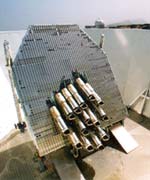
Image credit: RAS
Using a British radio telescope called the Very Small Array (VSA), located on the flanks of Mount Teide in Tenerife, astronomers from the Universities of Manchester and Cambridge and the Instituto de Astrofisica de Canarias (IAC) have made measurements of the Cosmic Microwave Background (CMB) – radiation left over from the Big Bang – which shed new light on events in the first minute fraction of the Universe’s existence.
By combining their results with those of NASA’s Wilkinson Microwave Anisotropy Probe (WMAP) satellite, they have been able to constrain the behaviour of the Universe during the ‘inflationary’ phase believed to have taken place when it was only 10(-35) seconds old. If confirmed, these results will significantly challenge our current views of inflation and the first moments of creation.
Dr. Richard Davis of Jodrell Bank Observatory, University of Manchester, who was involved in the design and building of the VSA and leads the Jodrell Bank team, said, “From the holiday island of Tenerife we have probed the first moment of creation, when the Universe was a million-million-millionth of the size of the atom. Using this British-funded instrument, we see echoes of the crazy expansion which took place in the early Universe; it is quite incredible!”
The idea of inflation is that the Universe expanded extremely quickly during its very early existence, creating a Universe whose properties are very uniform on the largest scales. However Quantum Mechanics, the theory of the sub-atomic world, would have created minute fluctuations in the density of the early Universe which eventually led to the formation of galaxies such as our own Milky Way. These fluctuations also imprinted minute temperature variations on the observed CMB, so allowing them to be studied by extremely sensitive instruments such as the VSA.
The Quantum Mechanical fluctuations produced variations in density and temperature over a very wide range of scale sizes. The finer detail of the VSA observations, as compared with those of WMAP, has enabled a better understanding of how the distribution of these fluctuations varies as a function of size.
Previous ideas had suggested that, once the subsequent history of the Universe is accounted for, the distribution of fluctuations would be independent of scale. However, the current results show that the fluctuations are most apparent at an angular scale of about 1/2 degree, the size of the Moon in the night sky. On both larger (the size of the Universe) and smaller (the size of a cluster of galaxies) scales, these variations in density and temperature are much less.
“The most popular inflation models predict much smaller variations than those seen in the new observations,” said Dr. Richard Battye (Jodrell Bank Observatory), who was involved in the analysis and interpretation of the data. “The increasing sensitivity of instruments such as the VSA is enabling us to test these inflation models. The results are not totally conclusive at this stage, but if true they will require a complete re-think of the prevailing view of the first moments of creation.”
The results from the VSA have been confirmed by a concurrent experiment, the Cosmic Background Imager (CBI), which is located high in the Chilean Andes and operated by the California Institute of Technology. The results at this stage are highly suggestive, but it is hoped that further measurements by the VSA, CBI and eventually the PLANCK satellite, will allow more definitive conclusions to be drawn. PLANCK, which is due to be launched by the European Space Agency in 2007, will employ highly sensitive receivers built by engineers at the Jodrell Bank Observatory.
Two papers detailing these results have been submitted to the Monthly Notices of the Royal Astronomical Society.
Original Source: RAS News Release
